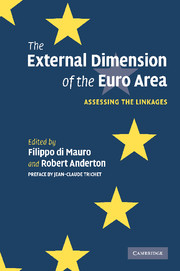Book contents
- Frontmatter
- Contents
- List of illustrations
- List of contributors
- Preface by Jean-Claude Trichet
- 1 Introduction
- 2 The external dimension of the euro area: stylised facts and initial findings
- 3 Product variety and macro trade models: implications for the new EU Member States
- 4 Exchange-rate pass-through to import prices in the euro area
- 5 The international equity holdings of euro area investors
- 6 Global linkages through foreign direct investment
- 7 Shocks and shock absorbers: the international propagation of equity market shocks and the design of appropriate policy responses
- 8 The euro area in the global economy: its sensitivity to the international environment and its influence on global economic developments
- Index
- References
2 - The external dimension of the euro area: stylised facts and initial findings
Published online by Cambridge University Press: 22 September 2009
- Frontmatter
- Contents
- List of illustrations
- List of contributors
- Preface by Jean-Claude Trichet
- 1 Introduction
- 2 The external dimension of the euro area: stylised facts and initial findings
- 3 Product variety and macro trade models: implications for the new EU Member States
- 4 Exchange-rate pass-through to import prices in the euro area
- 5 The international equity holdings of euro area investors
- 6 Global linkages through foreign direct investment
- 7 Shocks and shock absorbers: the international propagation of equity market shocks and the design of appropriate policy responses
- 8 The euro area in the global economy: its sensitivity to the international environment and its influence on global economic developments
- Index
- References
Summary
Although relatively closed in comparison with the individual constituent countries, the euro area economy is still rather open – particularly when compared with the two other largest world economies, the US and Japan. The experience of the first few years of EMU has shown that the euro area continues to be subject to a broad range of economic impacts originating from outside its borders, and that the extent of some external impacts are possibly higher than what might have been expected given the relatively-more internationally-insulated aggregate economy of the euro area. For example, the euro area was affected rather strongly by the ICT-related global downturn in early 2000, despite its relatively-low dependence on the ICT sector.
A full explanation of the above developments is a daunting task, particularly because aspects related to the effects of the creation of the monetary union are occurring at the same time as other impacts which are connected with global trends, such as rapid growth in world trade in goods and services, increased mobility of international capital, rising financial integration across the world, and rapid growth in the internationalisation and relocation of production. These difficulties notwithstanding, in several years of analysis of the external environment of the euro area we have learned quite a lot in terms of identification of the transmission channels of external shocks and their impacts.
- Type
- Chapter
- Information
- The External Dimension of the Euro AreaAssessing the Linkages, pp. 8 - 51Publisher: Cambridge University PressPrint publication year: 2007
References
- 1
- Cited by



